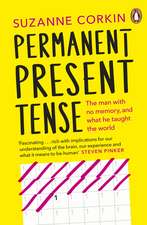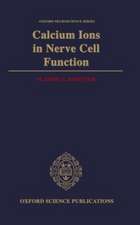Sensory-Motor Areas and Aspects of Cortical Connectivity: Volume 5: Sensory-Motor Areas and Aspects of Cortical Connectivity: Cerebral Cortex, cartea 5
Editat de Edward G. Jones, Alan Petersen Limba Engleză Paperback – 31 oct 1986
| Toate formatele și edițiile | Preț | Express |
|---|---|---|
| Paperback (2) | 961.86 lei 6-8 săpt. | |
| Springer Us – 5 noi 2011 | 961.86 lei 6-8 săpt. | |
| Springer Us – 31 oct 1986 | 1234.14 lei 6-8 săpt. |
Preț: 1234.14 lei
Preț vechi: 1505.05 lei
-18% Nou
Puncte Express: 1851
Preț estimativ în valută:
236.18€ • 256.46$ • 198.39£
236.18€ • 256.46$ • 198.39£
Carte tipărită la comandă
Livrare economică 23 aprilie-07 mai
Preluare comenzi: 021 569.72.76
Specificații
ISBN-13: 9780306421747
ISBN-10: 0306421747
Pagini: 510
Ilustrații: XVIII, 510 p.
Dimensiuni: 178 x 254 x 27 mm
Greutate: 0.92 kg
Ediția:1986
Editura: Springer Us
Colecția Springer
Seria Cerebral Cortex
Locul publicării:New York, NY, United States
ISBN-10: 0306421747
Pagini: 510
Ilustrații: XVIII, 510 p.
Dimensiuni: 178 x 254 x 27 mm
Greutate: 0.92 kg
Ediția:1986
Editura: Springer Us
Colecția Springer
Seria Cerebral Cortex
Locul publicării:New York, NY, United States
Public țintă
ResearchCuprins
1 What Makes a Map in Somatosensory Cortex?.- 1. A Statement of the Problem.- 2. A History of Mapmaking in Somatosensory Cortex.- 3. Questions Currently of Interest.- 4. The Process of Mapping: Some Practical Considerations.- 5. Biological Mapping Functions.- 6. Reorganization following Deafferentation.- 7. Organization following Nerve Regeneration.- 8. Other Clues to the Nature of Biological Mapping Functions.- 9. Summary.- 10. References.- 2 Second Somatosensory Cortex and Related Areas.- 1. Introduction: A Problem of Definitions.- 2. Somatotopic Organization in SII.- 3. The Cytoarchitecture of SII.- 4. Thalamocortical Connections.- 5. Corticocortical Connections.- 6. Corticofugal Connections.- 7. Physiological Responses.- 8. Lesion—Behavioral Studies.- 9. Conclusions.- 10. References.- 3 Vestibular Corte.- 1. Introduction.- 2. Parietal Cortical Projections.- 3. SI Forelimb Field Projection.- 4. Convergence.- 5. The Ascending Pathway to the Cortex.- 6. Clinical Implications.- 7. References.- 4 Connectivity of the Primate Sensory-Motor Corte.- 1. Introduction.- 2. Thalamic Inputs.- 3. Thalamocortical Connectivity.- 4. Subcortical Connections.- 5. Corticocortical Connections.- 6. Conclusions.- 7. Abbreviations.- 8. References.- 5 Functions of Corticocortical Neurons of Somatosensory, Motor, and Parietal Cortex.- 1. Introduction.- 2. Properties of Corticocortical Neurons.- 3. Effects of Corticocortical Neurons.- 4. What Information Is Carried by Corticocortical Neurons?.- 5. Conclusions.- 6. References.- 6 Motor Cortex Output in Primates.- 1. Motor Cortex Neurons and ? Motoneurons.- 2. Movements of Hand and Jaw.- 3. Transcortical Reflexes.- 4. References.- 7 Motor Cortex of Rodents.- 1. Introduction.- 2. Cortical Field Definition in Rodent Motor Cortex.- 3.Input—Output Organization of Rat Motor Cortex.- 4. Functional Specializations of Rodent Motor Cortex.- 5. Conclusions.- 6. References.- 8 Termination of Thalamic Afferents in the Cerebral Cortex.- 1. Introduction.- 2. Thalamocortical Topography.- 3. Correlations of Cortical Physiology with Thalamocortical Projections.- 4. Neurons Postsynaptic to Thalamic Afferents.- 5. Quantitative Aspects of Thalmocortical Synaptic Relations.- 6. Synaptic Sequences Involving Neurons Postsynaptic to Thalamic Afferents.- 7. Conclusions.- 8. References.- 9 General Organization of Callosal Connections in the Cerebral Cortex.- 1. Introduction.- 2. The Callosal Neurons.- 3. The Callosal Tract.- 4. The Termination of Callosal Axons.- 5. Corticotopic Organization of Callosal Connections.- 6. Function of Callosal Connections.- 7. The Development of Callosal Connections.- 8. Conclusions.- 9. References.- 10 The Thalamic Intralaminar Nuclei and the Cerebral Cortex.- 1. Historical Introduction.- 2. Cytoarchitectonic Delimitation of the Intralaminar Nuclei, with Notes on Their Comparative Anatomy.- 3. The Intralaminar—Cortical Projections.- 4. The Subcortical Efferents of the Intralaminar Nuclei.- 5. The Subcortical Afferents to the Intralaminar Nuclei.- 6. The Cortico-Intralaminar Projections.- 7. Functional Role of the Intralaminar System.- 8. Conclusions.- 9. References.- 11 New Perspectives on the Organization and Evolution of Nonspecific Thalamocortical Projections.- 1. Historical Origins of the Term “Nonspecific Thalamus”.- 2. A Tripartite Division of Thalamus Based on Cortical Layers of Termination.- 3. Evidence for a Paralaminar Layer I-Projecting System Demonstrated by Retrograde Tracing.- 4. Comparative Aspects of the Nonspecific Thalamocortical System.- 5. Cellular Origins ofLayer I Projections.- 6. Speculation on the Phylogeny of the Nonspecific Thalamus.- 7. Functional Considerations.- 8. References.- 12 Topography of Corticostriatal Projections in Nonhuman Primates and Implications for Functional Parcellation of the Neostriatum.- 1. Introduction.- 2. Early Views of Corticostriatal Projections.- 3. New Topography of Corticostriatal Projections.- 4. Segregation of Cortical Terminal Fields in the Striatum: Double-Labeling Studies.- 5. Interdigitation of Cortical Terminal Fields in the Neostriatum.- 6. Neostriatal Compartments and Their Relationship to Corticostriatal Projections.- 7. Cortical Laminar Origin of the Striatal Projection.- 8. Implications for Neostriatal Function.- 9. Implications for Neurological Disease.- 10. References.- 13 The Claustrum and the Cerebral Cortex.- 1. Introduction.- 2. Location, Shape, and Cellular Composition of Claustrum.- 3. Development of Claustrum.- 4. Cortical Connections of Claustrum.- 5. Subcortical Connections of Claustrum.- 6. Physiological Properties of Claustral Neurons.- 7. Visual Field Map in Claustrum.- 8. Function of Claustrum.- 9. References.




















